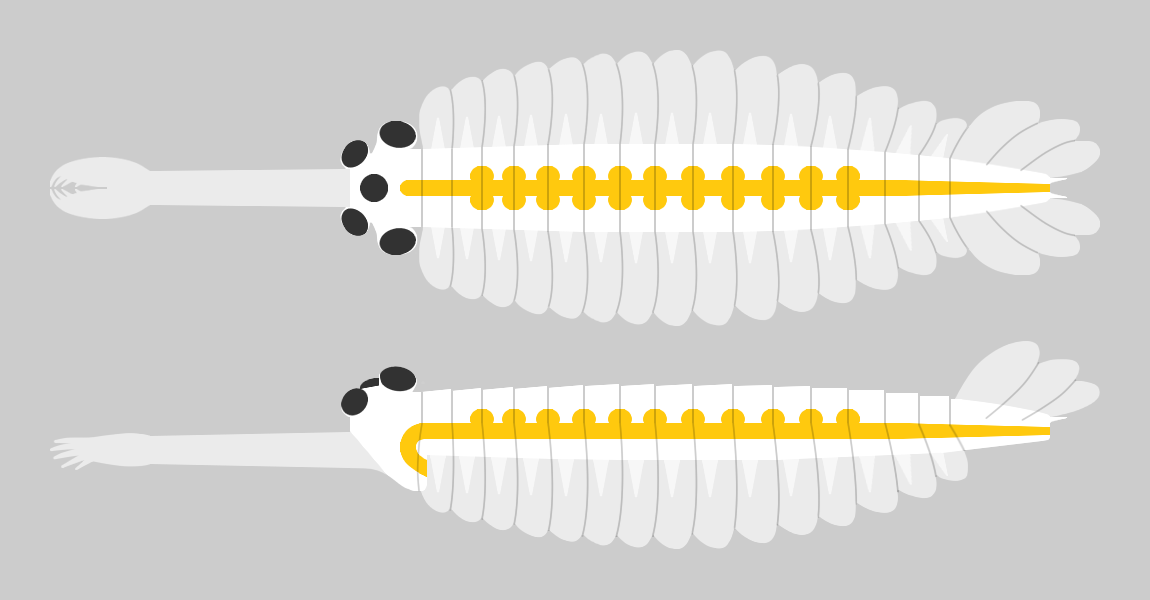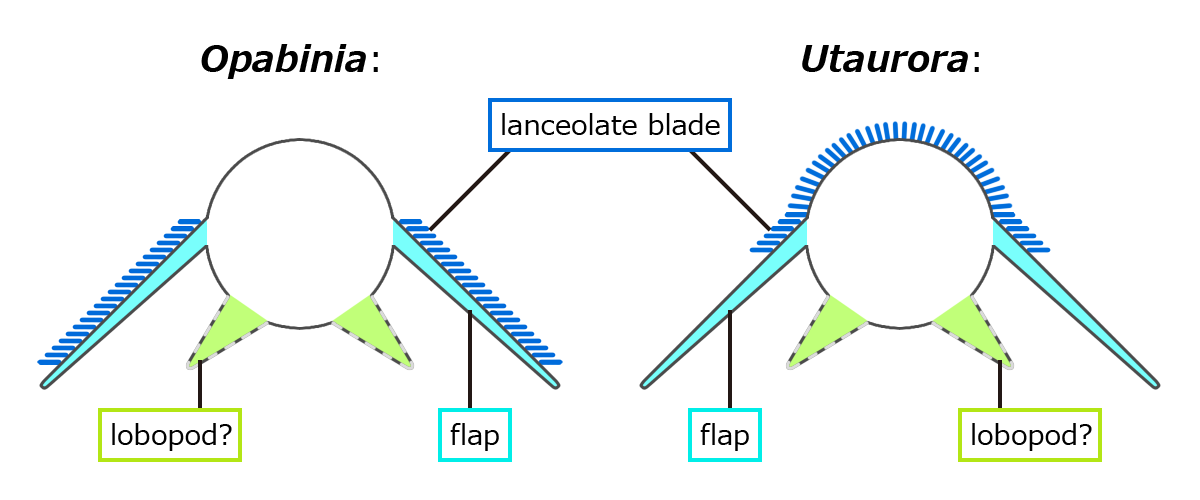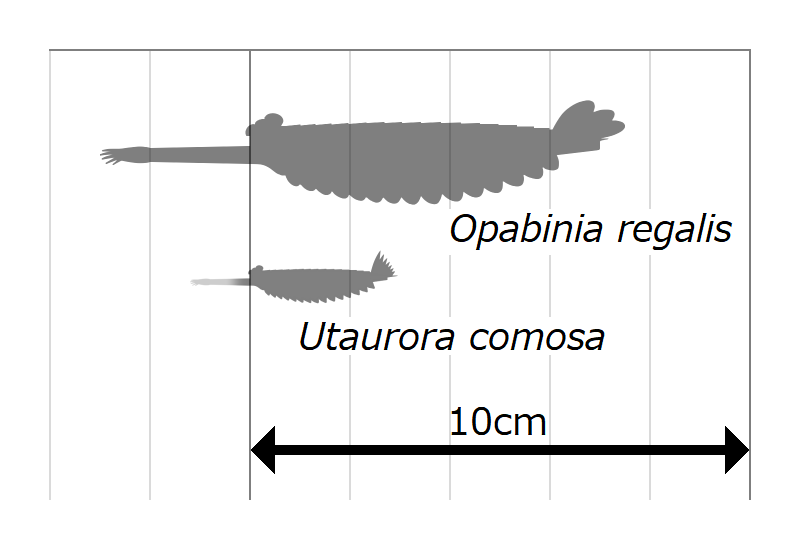|
Utaurora
''Utaurora'' is an extinct genus of opabiniid, which were bizarre stem-arthropods closely related to true arthropods and radiodonts; the type species is ''U. comosa''. The animal's fossils come from the Cambrian of Utah. This genus is so far the only other known unquestionable opabiniid, with the other being ''Opabinia'' itself. There are other animals like ''Myoscolex'' and ''Mieridduryn'' that could be opabiniids, but the classification of those two genera is still debated. History of study The holotype specimen of ''Utaurora comosa'', KUMIP 314087, was collected from the Wheeler Formation in Utah. It was initially described as a specimen of ''Anomalocaris'' in 2008. In 2022, Pates ''et al.'' reinterpreted the specimen as an opabiniid and described it as a new genus and species. Etymology ''Utaurora'' is a portmanteau of Utah, in reference to where the specimen was found, and Aurora, the name of a Roman goddess. The reference to Aurora was chosen as she is a goddess of the da ... [...More Info...] [...Related Items...] OR: [Wikipedia] [Google] [Baidu] |
Opabinia
''Opabinia regalis'' is an extinct, stem group arthropod found in the Middle Cambrian Burgess Shale Lagerstätte (505 million years ago) of British Columbia. ''Opabinia'' was a soft-bodied animal, measuring up to 7 cm in body length, and its segmented trunk had flaps along the sides and a fan-shaped tail. The head shows unusual features: five eyes, a mouth under the head and facing backwards, and a clawed proboscis that probably passed food to the mouth. ''Opabinia'' probably lived on the seafloor, using the proboscis to seek out small, soft food. Free abstract at Fewer than twenty good specimens have been described; 3 specimens of ''Opabinia'' are known from the Greater Phyllopod bed, where they constitute less than 0.1% of the community. When the first thorough examination of ''Opabinia'' in 1975 revealed its unusual features, it was thought to be unrelated to any known phylum, or perhaps a relative of arthropod and annelid ancestors. However, later studies since late 19 ... [...More Info...] [...Related Items...] OR: [Wikipedia] [Google] [Baidu] |
Opabiniidae
Opabiniidae is an extinct family of bizarre marine stem-arthropods. Its type and best-known genus is ''Opabinia''. It also contains ''Utaurora''. Opabiniids closely resemble radiodonts, but their frontal appendages were basally fused into a proboscis. Opabiniids also distinguishable from radiodonts by setal blades covering at least part of the body flaps and serrated caudal rami. History of study Opabiniidae was named by Charles Doolittle Walcott in 1912, alongside its type species ''Opabinia''. Walcott interpreted Opabiniidae as a family of anostracan crustaceans, most closely related to Thamnocephalidae. ''Opabinia'' was restudied in the 1970s, and reinterpreted as a stranger animal. Stephen Jay Gould referred to ''Opabinia'' as a "weird wonder", and an illustration of ''Opabinia'' prompted laughter when it was first revealed at a paleontological conference. In 2022, a second opabiniid, ''Utaurora'', was identified. ''Myoscolex'' from Emu Bay Shale is sometimes suggested to ... [...More Info...] [...Related Items...] OR: [Wikipedia] [Google] [Baidu] |
Opabiniid
Opabiniidae is an extinct family of bizarre marine stem- arthropods. Its type and best-known genus is ''Opabinia''. It also contains ''Utaurora''. Opabiniids closely resemble radiodonts, but their frontal appendages were basally fused into a proboscis. Opabiniids also distinguishable from radiodonts by setal blades covering at least part of the body flaps and serrated caudal rami. History of study Opabiniidae was named by Charles Doolittle Walcott in 1912, alongside its type species ''Opabinia''. Walcott interpreted Opabiniidae as a family of anostracan crustaceans, most closely related to Thamnocephalidae. ''Opabinia'' was restudied in the 1970s, and reinterpreted as a stranger animal. Stephen Jay Gould referred to ''Opabinia'' as a "weird wonder", and an illustration of ''Opabinia'' prompted laughter when it was first revealed at a paleontological conference. In 2022, a second opabiniid, ''Utaurora'', was identified. ''Myoscolex'' from Emu Bay Shale is sometimes suggested ... [...More Info...] [...Related Items...] OR: [Wikipedia] [Google] [Baidu] |
Radiodonta
Radiodonta is an extinct Order (biology), order of stem-group arthropods that was successful worldwide during the Cambrian period. They may be referred to as radiodonts, radiodontans, radiodontids, anomalocarids, or anomalocaridids, although the last two originally refer to the family Anomalocarididae, which previously included all species of this order but is now restricted to only a few species. Radiodonts are distinguished by their distinctive frontal appendages, which are morphologically diverse and used for a variety of functions. Radiodonts included the earliest large predators known, but they also included sediment sifters and filter feeders. Some of the most famous species of radiodonts are the Cambrian taxa ''Anomalocaris, Anomalocaris canadensis'', ''Hurdia, Hurdia victoria'', ''Peytoia nathorsti'', ''Titanokorys gainesii, Titanokorys gainessii, Cambroraster, Cambroraster falcatus'' and ''Amplectobelua, Amplectobelua symbrachiata'', the Ordovician ''Aegirocassis, Aegiroca ... [...More Info...] [...Related Items...] OR: [Wikipedia] [Google] [Baidu] |
Wheeler Formation
The Wheeler Shale (named by Charles Walcott) is a Cambrian ( 507 Ma) fossil locality world-famous for prolific agnostid and ''Elrathia kingii'' trilobite remains (even though many areas are barren of fossils) and represents a Konzentrat-Lagerstätte. Varied soft bodied organisms are locally preserved, a fauna (including ''Naraoia'', ''Wiwaxia'' and ''Hallucigenia'') and preservation style (carbonaceous film) normally associated with the more famous Burgess Shale. As such, the Wheeler Shale also represents a Konservat-Lagerstätten. Together with the Marjum Formation and lower Weeks Formation, the Wheeler Shale forms of limestone and shale exposed in one of the thickest, most fossiliferous and best exposed sequences of Middle Cambrian rocks in North America. At the type locality of Wheeler Amphitheater, House Range, Millard County, western Utah, the Wheeler Shale consists of a heterogeneous succession of highly calcareous shale, shaley limestone, mudstone and thi ... [...More Info...] [...Related Items...] OR: [Wikipedia] [Google] [Baidu] |
Myoscolex
''Myoscolex'' is an early animal species known from the Cambrian Emu Bay Shale in South Australia. It was interpreted as an annelid and some supports that theory, while it was also considered as an arthropod close to ''Opabinia'', through other studies questions that interpretation. ''Myoscolex'' is the earliest known example of phosphotized muscle tissue, and as to which shows distinct annulation. Etymology ''Myoscolex ateles'' derives its name from Greek, "Myo-" meaning muscle, "Scolex" meaning worm, and "Ateles" meaning incomplete. This definition of "Incomplete muscle worm" is due to its initial identification as a "muscular" annelid worm with indistinct features after fossilization. Description As an Opabiniid When described as an Opabiniid, ''Myoscolex'' is said to have at least 3 eyes, a thin proboscis jutting from under the proposed eyes, lateral lobes on the trunk, a tail fan on the posterior segments, and an upwardly curving trunk. It would have lived as a fast n ... [...More Info...] [...Related Items...] OR: [Wikipedia] [Google] [Baidu] |
Middle Cambrian
Middle or The Middle may refer to: * Centre (geometry), the point equally distant from the outer limits. Places * Middle (sheading), a subdivision of the Isle of Man * Middle Bay (other) * Middle Brook (other) * Middle Creek (other) * Middle Island (other) * Middle Lake (other) * Middle Mountain, California * Middle Peninsula, Chesapeake Bay, Virginia * Middle Range, a former name of the Xueshan Range on Taiwan Island * Middle River (other) * Middle Rocks, two rocks at the eastern opening of the Straits of Singapore * Middle Sound, a bay in North Carolina * Middle Township (other) * Middle East Music *Middle (song), "Middle" (song), 2015 *The Middle (Jimmy Eat World song), "The Middle" (Jimmy Eat World song), 2001 *The Middle (Zedd, Maren Morris and Grey song), "The Middle" (Zedd, Maren Morris and Grey song), 2018 *"Middle", a song by Rocket from the Crypt from their 1995 album ''Scream, Dracula, Scream!'' *"The Middle ... [...More Info...] [...Related Items...] OR: [Wikipedia] [Google] [Baidu] |
Maotianshan Shales
The Maotianshan Shales are a series of Cambrian, Early Cambrian deposits in the Chiungchussu Formation, famous for their ''Lagerstätte, Konservat Lagerstätten'', deposits known for the exceptional preservation of fossilized organisms or traces. The Maotianshan Shales form one of some forty Cambrian fossil locations worldwide exhibiting exquisite preservation of rarely preserved, non-mineralized soft tissue, comparable to the fossils of the Burgess Shale. They take their name from Maotianshan Hill (, Literal meaning: Hat Sky Mountain) in Chengjiang County, Yunnan Province, China. The most famous assemblage of organisms are referred to as the Chengjiang biota for the multiple scattered fossil sites in Chengjiang. The age of the Chengjiang Lagerstätte is locally termed Qiongzhusian, a stage correlated to the late Atdabanian Stage in Siberian sequences of the middle of the Early Cambrian. The shales date to ≤. The shales also contain the slightly younger Guanshan biota from Mal ... [...More Info...] [...Related Items...] OR: [Wikipedia] [Google] [Baidu] |
Aysheaia
''Aysheaia'' is an extinct genus of soft-bodied lobopod, known from the middle Cambrian of North America, with an average body length of 1–6 cm. Anatomy ''Aysheaia'' has ten body segments, each of which has a pair of spiked, annulate legs. The animal is segmented, and looks somewhat like a bloated caterpillar with a few spines added on — including six finger-like projections around the mouth and two grasping legs on the "head". Each leg has a subterminal row of about six curved claws. No jaw apparatus is evident. A pair of legs marks the posterior end of the body, unlike in onychophorans where the anus projects posteriad; this may be an adaptation to the terrestrial habit. Ecology Based on its association with sponge remains, it is believed that ''Aysheaia'' was a sponge grazer and may have protected itself from predators by seeking refuge within sponge colonies. ''Aysheaia'' probably used its claws to cling to sponges. A terminal mouth is also seen in tardigrades th ... [...More Info...] [...Related Items...] OR: [Wikipedia] [Google] [Baidu] |
Onychodictyon
''Onychodictyon'' is a genus of extinct lobopodian known from the Lower Cambrian Chengjiang Maotianshan Shales in the Yunnan Province in China. It was characterized by a stout body covered by fleshy papillae and pairs of sclerotized plates with spines, representing part of the diverse "armoured lobopodians" alongside similar forms such as ''Microdictyon'' and ''Hallucigenia''. The maximum length of ''Onychodictyon'' is . It has a resemblance to ''Microdictyon'' (net-like sclerite ornament) but also ''Aysheaia'' and tardigrade Tardigrades (), known colloquially as water bears or moss piglets, are a phylum of eight-legged segmented micro-animals. They were first described by the German zoologist Johann August Ephraim Goeze in 1773, who called them Kleiner Wasserbär ... (basally-fused terminal leg pair). Each leg have a pair of curved claws that are thought to have aided ''Onychodictyon'' climb onto other organisms. ''Onychodictyon'' sclerites appear to have molted with some ... [...More Info...] [...Related Items...] OR: [Wikipedia] [Google] [Baidu] |
Tardigrada
Tardigrades (), known colloquially as water bears or moss piglets, are a phylum of eight-legged segmented micro-animals. They were first described by the German zoologist Johann August Ephraim Goeze in 1773, who called them Kleiner Wasserbär ("little water bear"). In 1777, the Italian biologist Lazzaro Spallanzani named them Tardigrada (), which means "slow steppers". They have been found in diverse regions of Earth's biospheremountaintops, the deep sea, tropical rainforests, and the Antarctic. Tardigrades are among the most resilient animals known, with individual species able to survive extreme conditions – such as exposure to extreme temperatures, extreme pressures (both high and low), air deprivation, radiation, dehydration, and starvation – that would quickly kill most other known forms of life. Tardigrades have survived exposure to outer space. There are about 1,300 known species in the phylum Tardigrada, a part of the superphylum Ecdysozoa consisting of animal ... [...More Info...] [...Related Items...] OR: [Wikipedia] [Google] [Baidu] |
Kylinxia
''Kylinxia'' is a genus of extinct arthropod described in 2020. It was described from six specimens discovered in Yu'anshan Formation (Maotianshan Shales) in southern China. The specimens are assigned to one species ''Kylinxia zhangi.'' Dated to 518 million years, the fossils falls under the Cambrian period. Announcing the discovery on 4 November 2020 at a press conference, Zeng Han of the Nanjing Institute of Geology and Paleontology, said that the animal "bridges the evolutionary gap from ''Anomalocaris'' to true arthropods and forms a key ‘ missing link’ in the origin of arthropods," which was "predicted by Darwin’s evolutionary theory." The same day the formal description was published in ''Nature''. Discovery ''Kylinxia zhangi'' was discovered among the Maotianshan Shales from Yu'anshan Formation at Yunnan in southern China in 2019. Zeng Han, Zhao Fangchen, and Huang Diying of the Nanjing Institute of Geology and Palaeontology, Chinese Academy of Sciences, made the ... [...More Info...] [...Related Items...] OR: [Wikipedia] [Google] [Baidu] |










